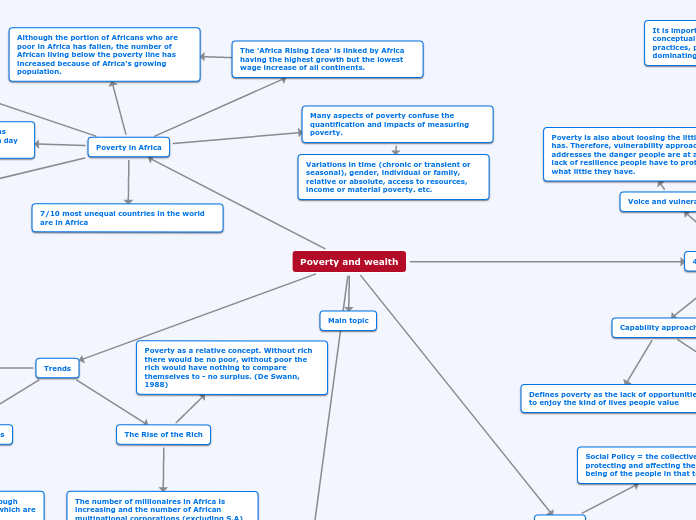What is Poverty?
"Broke" vs. Poverty
People in poverty see their situatuation as a hopeless, permanent condition
Being "broke" is a temporary state
Current poverty level:
Family of four: $18,850
Family of three: $15, 670
Family of two: $12,490
Chapter 12: Poverty
Effects of Poverty on Children and their Families
Increase in Stress and Conflict
As money decreases, parents' stress levels and depression go up giving way to conflict and the increased chance of child abuse and neglect
Lack of Health Care, Health Supplies, and Safety Devices
The result is that poor people are less likely to seek care early in a disease's history and more likely to delay until the illness is so bad that care must be sought from an emergency room
Inadequate funding for Healthy Recreation
Children may be exposed to things (drugs) and groups (gangs) that both put them at risk and would be less of an issue if the families had the resources available to others
Limited Transportation, Communication, and Economic Opportunity
Lack of transportation may limit access to child care, health services, recreation, jobs, job-training programs, postsecondary education, and low-cost stores
Poor Neighborhood
Less likely to have libraries, organized recreational oppurtuniites, and parks
More crime and pollution
Less Opportunities to Learn
Children in poverty also have greater home responsibilities that compete with school and schoolwork
Poor children have fewer educational materials at home (including computers) and fewer stimulating activities (such as trips, lessons, museums, concerts)
Children are more likely to attend an inferior school that has difficulty retaining skilled teachers and administrators
Lack of Safe and Decent Shelter, Homelessness, Inadequate Housing, Frequent Moves from House to House
Inadequate housing includes problems such as heating and electricity difficulties, utility shutoffs, cold and dampness, mold and allergies, cockroaches and rats, peeling paing and falling plaster, lead poisoning, crowded housing, and fire=-prone homes
Lack of Good Food
May result in iron deficiency, hunger, stunted growth, clinical maalnutrition, increased rate of high-risk pregnancies and premature births
Myths about Poverty
MYTH: "Urban counties have the highest poverty rates in the US"
FACT: Couties with disproportionately high rates of persistent poverty are often rural
MYTH: "In school, children from food-insecure households perform just as well as children who have enough daily nutrition"
FACT: Children from food-insecure households are more likely to experience irritability, fatigue, and difficulty concentrating compared with other children
MYTH: "The lack of adequate nutrition only affects children's physical growth"
FACT: Lack of adequate nutrition affects the cognitive and behavioral development of children
MYTH: "Most people in low-income households would be fine if they just worked harder"
FACT: 36% of households served by the Feeding America network include at least one adult who works
MYTH: "Very few children struggle with hunger because of provided programs"
FACT: 14 million children live in food-insecure households
Demographics
More than 49 million Americans don't have dependable, consistent access to enough food due to limited money and resources
Even college-educated people struggle with issues of hunger in this country
1 in 6 Americans does not have access to enough food
New additions to the families of the working poor and those in poverty include former working- and middle-class families whose members have lost their jobs and/or homes
Many of these families are headed by a single parent--usually the mother
21% of children in the families of the working poor live in poverty
2008 statistics reflect that 14 million (19%) of children under the age of 18 live in poverty
Homelessness
Five Principles for Educators Regarding Homelessness
Reach out to the community
Work with parents or guardians to develop concrete goals and plans to address those goals
Think of the needs of the whole child
Make schools safe havens
Do not stigmatize children in homeless situations
Effects of Homelessness on Children
Twice as likely to repeat a grade compared with other children
Have twice the rate of learning disabilities and three times the rate of emotional and behavioral problems of other children
Half of school-age homeless children experience anxiety, depression, or withdrawal from educational, community, and social activities
More than one-fifth of homeless preschoolers have emotional problems serious enough to require professional care, but less than one-third of them receive treatment
Go hungry twice as often as other kids
Sick twice as often as other children: suffer twice as many ear infections, have four times the rate of asthma, and have five times more diarrhea and stomach problems
Children bear the brunt of homelessness
Can exacerbate other trauma-related difficulties and interfere with insufficient resources available to allow recovery
Places families at greater risk of additional traumatic experiences such as assault, witnessing violence, or abrupt separation
Gereral Characteristics of Homeless Families
More than half of all homeless mothers do not have a high school diploma
84% of families are female-headed
42% of chidren in homeless families are under age 6
Adults in the homeless families work (co-workers are often unaware of homeless status)
Mother is in late twenties
What is Homelessness?
Families who lack a fixed, regular, and adequate night-time residence
Caused by a combination of factors including the effects of a lack of affordable housing, extreme poverty, decreasing government support, changing demographics of the family, the challenges of single parenthood, domestic violence, and fractured social supports
Effects of Money on Children and their Families
Reduced Family Stress and Conflict
Health Care, Health Supplies, and Safety Devices
Healthy Recreation
Transportation, Communication, and Economic Opportunity
Decent Neighborhood
More resources, better schools
Less crime
Opportunities to Learn
Often attend superior schools with skilled teachers and administrators, adequate supplies and equipment
Children enter school with a strong educational background and degree of familiarity with computers
Safe and Decent Shelter
Good Food
Results in helathy children
Relationship between Schools and Families of Poverty
Children
Commonly lack middle-class social and language behaviors
Enter schools that were designed for someone else
Often experience discontinuities beween schooling and other areas of their lives
Parents
Limited school involvment can be attributed, in part, to:
lack of information, skill, time, and transportation
discomfort on the part of parents when interacting with schools due to differences in economic background between teachers
lack of undertanding of the ways schools function
lack of trust in school personnel
Home environment is often cited as the reason for lack of academic achievement among low-income students
Substantial numbers of parents of children of poverty dropped out of school before completing high school
These parents are often criticized for not being sufficiently involved at school, for not working with their children at home, and for not attending parent-teacher conferences without taking in consideration circumstances of survival issues
These parents are unprepared to help their children at school
School Expectations
Results of research reveal that schools expect students to have middle-class experiences and opportuniites; and evaluate children's behavior and scholastic outcomes with middle-class standards
Working with Low-Income Families
Teachers must take a make a conscious effort to gain the perspectives needed to understand student experiences if different than their own
Be sensitive to the Financial Limitations of Low-Income Families
Consider the financial restrictions facing families when requesting money for field trips, school projects, special materials, food for special events, registration fees, and extracurricular activity fees
Get creative in raising funds with your students to support school activities!
Become Involved in the Community
Consider attending community celebrations, student performances, sporting events, church celebrations, etc.
Create a Partnership
Important to remember that the stresses of life on low-income parents may decrease the emotional or physical energy needed to be full partners at times
Flexibility, practicality, and creativity can help you mitigate some of the problems associated with lack of resources faced by low-income families: less time, negative school experiences, discomfort in the school environment
Communicate with the Low-Income Parents and Children
If a parent understands that you like and appreciate their child, parental enthusiasm in school matters is more likely to result
Contact paretns about positive matters first
Two-way communication model is best!
Gather Information
Get acquainted with the dynamics of the families
Do they have a phone? Work number?
Address?
How many adults work?
How many parents/guardians?
How many children? Ages?
Know the Environment
Walk or drive around the neighborhoods in which your students live; walk through the stores; note the existence or absence of parks, churches, libraries, bars, etc.; observe the safety and cultural make-up of the neighborhood
Identify the strengths and weaknesses of the area and determine how these will affect your teaching strategies
Check Attitude
Examine attitudes toward poverty
Understand your students' situations so that your expectations and teaching are in alignment (this does not mean lower expectations)
Unless educators have had exposure to poverty, they will subconsciously take their middle-class expectaitons of parent-school reltionships into their classrooms with them









